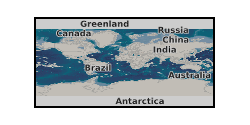Oceanic ridges
Type of resources
Topics
Keywords
Contact for the resource
Provided by
Years
Formats
Update frequencies
-

Theoretical waveforms computed to study earthquakes in the Azores archipelago. Grant abstract: How do earthquakes happen? Understanding the nature of earthquakes is a key fundamental question in Geociences that holds many implications for society. Earthquakes are typically associated with a sudden release of energy that has slowly accumulated over hundreds to thousands of years, being strongly controlled by friction in faults buried several kilometers beneath our feet under quite extreme conditions. For example, the amount of heat produced in just a few seconds is such that it can dramatically change the nature of the fault zone near the sliding surface. Moreover, there is abundant evidence of substantial frictional weakening of faults (i.e., fault strength weakens with increasing slip or slip rate) during earthquakes. However, there are still many open questions related to earthquake source processes: How similar are earthquakes in different temperature-pressure conditions? What is the earthquake's energy budget, which controls the intensity of ground motions? What are the physical mechanisms responsible for fault weakening? Recent progress in seismological imaging methods, theoretical fracture mechanics and rupture dynamics simulations can help solve these questions. Huge volumes of freely available seismic and geodetic data from around the world now allow the routine calculation of earthquake models where earthquakes are typically described as single space-time points. Time is now ripe for systematically building robust, more detailed seismic models bearing information on earthquake's physics by using recently developed sophisticated modelling tools along with high-quality images of the 3-D Earth's interior structure enabled by high performance computing facilities. Moreover, it is now possible to model ruptures theoretically in detail using both analytical fracture mechanics calculations and numerical rupture dynamics simulations, and, for example, estimate the fault temperature during the rupture process, which is the most direct way to quantify friction. However, systematic quantitative links between these calculations and seismological observations are still lacking. This project addresses these issues through a coordinated effort involving seismology and rock mechanics aiming at estimating fault temperature rise during earthquakes from new macroscopic seismic source models. We will use advanced seismic source imaging methods to build a new set of robust kinematic, static and dynamic earthquake source parameters for a large selected set of global earthquakes (e.g., average fault length, width, rupture speed and time history, stress drop, radiated and fracture energy). These solutions will then be used as input parameters to estimate fault temperature using analytical and numerical rupture dynamics calculations. This will lead to an improved understanding of how local fault processes occurring at scales from few microns to tens of centimetres translate into macroscopic seismological properties, how energy is partitioned during earthquakes and which are the mechanisms responsible for fault weakening. Ultimately this project will shed new light on many basic questions in earthquake science such as the similarity of earthquakes in different P-T conditions and the potential geological record left by ruptures (e.g., melt). More broadly, this project will benefit hazard models and any studies relying on accurate earthquake source parameters such as studies in seismic tomography, active tectonics and microseismicity (e.g., associated with hydraulic fracturing).
-

Observed global seismograms used to study earthquakes in the Azores. The seismograms have been processed and then have been used to perform source inversions of the events.
-

Broadband data collected at the equatorial Mid-Atlantic Ridge from March 2016 to March 2017. From the Grant abstract: We will systematically image the entire length of an oceanic plate, from its birth at the Mid Atlantic Ridge to its oldest formation on the African margin. This is a large-scale focused effort with multiple scales of resolution and sensitivity, from a metre to kilometre scale using seismic and electromagnetic methods. This scale, focus, and interdisciplinary approach will finally determine the processes and properties that make a plate strong and define it. The project will be accomplished through a large, focused international collaboration that involves EU partners (3.5 M euro) and industry (6.4M euro), both already funded.
-

Two published papers: Modelling the Lost City Hydrothermal Field: Influence of topography and Permeability structure. https://doi.org/10.1111/gfl.12151: and Rapid generation of reaction permeability in the roots of black smoker systems, Troodos ophiolite Cyprus. https://doi.org/10.1111/gfl.12117
 NERC Data Catalogue Service
NERC Data Catalogue Service